Water resources
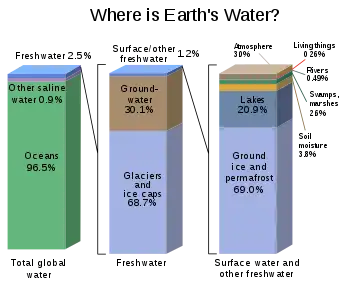
Water resources are natural resources of water that are potentially useful as a source of water supply. 97% of the water on the Earth is salt water and only three percent is fresh water; slightly over two thirds of this is frozen in glaciers and polar ice caps.[1] The remaining unfrozen freshwater is found mainly as groundwater, with only a small fraction present above ground or in the air.[2] Natural sources of fresh water include surface water, under river flow, groundwater and frozen water. Artificial sources of fresh water can include treated wastewater (reclaimed water) and desalinated seawater.
Uses of water include agricultural, industrial, household, recreational and environmental activities.
Water resources are under threat from water scarcity, water pollution, water conflict and climate change. Fresh water is a renewable resource, yet the world's supply of groundwater is steadily decreasing, with depletion occurring most prominently in Asia, South America and North America, although it is still unclear how much natural renewal balances this usage, and whether ecosystems are threatened.[3] The framework for allocating water resources to water users (where such a framework exists) is known as water rights.
Sources of useful water
Natural sources of fresh water
Natural sources of fresh water include surface water, under river flow, groundwater and frozen water.
Surface water
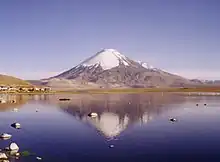
Surface water is water in a river, lake or fresh water wetland. Surface water is naturally replenished by precipitation and naturally lost through discharge to the oceans, evaporation, evapotranspiration and groundwater recharge.
Although the only natural input to any surface water system is precipitation within its watershed, the total quantity of water in that system at any given time is also dependent on many other factors. These factors include storage capacity in lakes, wetlands and artificial reservoirs, the permeability of the soil beneath these storage bodies, the runoff characteristics of the land in the watershed, the timing of the precipitation and local evaporation rates. All of these factors also affect the proportions of water loss.
Human activities can have a large and sometimes devastating impact on these factors. Humans often increase storage capacity by constructing reservoirs and decrease it by draining wetlands. Humans often increase runoff quantities and velocities by paving areas and channelizing the stream flow.
The total quantity of water available at any given time is an important consideration. Some human water users have an intermittent need for water. For example, many farms require large quantities of water in the spring, and no water at all in the winter. To supply such a farm with water, a surface water system may require a large storage capacity to collect water throughout the year and release it in a short period of time. Other users have a continuous need for water, such as a power plant that requires water for cooling. To supply such a power plant with water, a surface water system only needs enough storage capacity to fill in when average stream flow is below the power plant's need.
Nevertheless, over the long term the average rate of precipitation within a watershed is the upper bound for average consumption of natural surface water from that watershed.
Natural surface water can be augmented by importing surface water from another watershed through a canal or pipeline. It can also be artificially augmented from any of the other sources listed here, however in practice the quantities are negligible. Humans can also cause surface water to be "lost" (i.e. become unusable) through pollution.
Brazil is estimated to have the largest supply of fresh water in the world, followed by Russia and Canada.[4]
 Panorama of a natural wetland (Sinclair Wetlands, New Zealand)
Panorama of a natural wetland (Sinclair Wetlands, New Zealand)
Under river flow
Throughout the course of a river, the total volume of water transported downstream will often be a combination of the visible free water flow together with a substantial contribution flowing through rocks and sediments that underlie the river and its floodplain called the hyporheic zone. For many rivers in large valleys, this unseen component of flow may greatly exceed the visible flow. The hyporheic zone often forms a dynamic interface between surface water and groundwater from aquifers, exchanging flow between rivers and aquifers that may be fully charged or depleted. This is especially significant in karst areas where pot-holes and underground rivers are common.
Groundwater
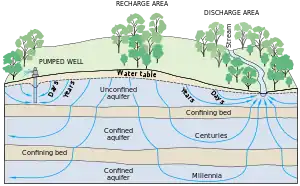
Groundwater is fresh water located in the subsurface pore space of soil and rocks. It is also water that is flowing within aquifers below the water table. Sometimes it is useful to make a distinction between groundwater that is closely associated with surface water and deep groundwater in an aquifer (sometimes called "fossil water").
Groundwater can be thought of in the same terms as surface water: inputs, outputs and storage. The critical difference is that due to its slow rate of turnover, groundwater storage is generally much larger (in volume) compared to inputs than it is for surface water. This difference makes it easy for humans to use groundwater unsustainable for a long time without severe consequences. Nevertheless, over the long term the average rate of seepage above a groundwater source is the upper bound for average consumption of water from that source.
The natural input to groundwater is seepage from surface water. The natural outputs from groundwater are springs and seepage to the oceans.
If the surface water source is also subject to substantial evaporation, a groundwater source may become saline. This situation can occur naturally under endorheic bodies of water, or artificially under irrigated farmland. In coastal areas, human use of a groundwater source may cause the direction of seepage to ocean to reverse which can also cause soil salinization. Humans can also cause groundwater to be "lost" (i.e. become unusable) through pollution. Humans can increase the input to a groundwater source by building reservoirs or detention ponds.
Frozen water
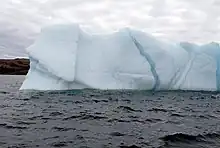
Several schemes have been proposed to make use of icebergs as a water source, however to date this has only been done for research purposes. Glacier runoff is considered to be surface water.
The Himalayas, which are often called "The Roof of the World", contain some of the most extensive and rough high altitude areas on Earth as well as the greatest area of glaciers and permafrost outside of the poles. Ten of Asia's largest rivers flow from there, and more than a billion people's livelihoods depend on them. To complicate matters, temperatures there are rising more rapidly than the global average. In Nepal, the temperature has risen by 0.6 degrees Celsius over the last decade, whereas globally, the Earth has warmed approximately 0.7 degrees Celsius over the last hundred years.[5]
Artificial sources of usable water
Artificial sources of fresh water can include treated wastewater (reclaimed water) and desalinated seawater. However, economic and environmental side effects of these technologies must also be taken into consideration.[6]
Reclaimed water
Water reclamation (also called wastewater reuse, water reuse or water recycling) is the process of converting municipal wastewater (sewage) or industrial wastewater into water that can be reused for a variety of purposes. Types of reuse include: urban reuse, agricultural reuse (irrigation), environmental reuse, industrial reuse, planned potable reuse, de facto wastewater reuse (unplanned potable reuse). For example, reuse may include irrigation of gardens and agricultural fields or replenishing surface water and groundwater (i.e., groundwater recharge). Reused water may also be directed toward fulfilling certain needs in residences (e.g. toilet flushing), businesses, and industry, and could even be treated to reach drinking water standards. Treated municipal wastewater reuse for irrigation is a long-established practice, especially in arid countries. Reusing wastewater as part of sustainable water management allows water to remain as an alternative water source for human activities. This can reduce scarcity and alleviate pressures on groundwater and other natural water bodies.[7]
There are several technologies used to treat wastewater for reuse. A combination of these technologies can meet strict treatment standards and make sure that the processed water is hygienically safe, meaning free from pathogens. The following are some of the typical technologies: Ozonation, ultrafiltration, aerobic treatment (membrane bioreactor), forward osmosis, reverse osmosis, advanced oxidation.[8] Some water demanding activities do not require high grade water. In this case, wastewater can be reused with little or no treatment.Desalination
Desalination is a process that takes away mineral components from saline water. More generally, desalination refers to the removal of salts and minerals from a target substance,[9] as in soil desalination, which is an issue for agriculture. Saltwater (especially sea water) is desalinated to produce water suitable for human consumption or irrigation. The by-product of the desalination process is brine.[10] Desalination is used on many seagoing ships and submarines. Most of the modern interest in desalination is focused on cost-effective provision of fresh water for human use. Along with recycled wastewater, it is one of the few rainfall-independent water resources.[11]
Due to its energy consumption, desalinating sea water is generally more costly than fresh water from surface water or groundwater, water recycling and water conservation. However, these alternatives are not always available and depletion of reserves is a critical problem worldwide.[12][13] Desalination processes are usually driven by either thermal (in the case of distillation) or mechanical (e.g. in the case of reverse osmosis) energy types.[14]Water uses
Agriculture and other irrigation
It is estimated that 70% of worldwide water is used for irrigation, with 15–35% of irrigation withdrawals being unsustainable.[15] It takes around 2,000 – 3,000 litres of water to produce enough food to satisfy one person's daily dietary need.[16] This is a considerable amount, when compared to that required for drinking, which is between two and five litres. To produce food for the now over 7 billion people who inhabit the planet today requires the water that would fill a canal ten metres deep, 100 metres wide and 2100 kilometres long.
An assessment of water management in agriculture sector was conducted in 2007 by the International Water Management Institute in Sri Lanka to see if the world had sufficient water to provide food for its growing population.[17] It assessed the current availability of water for agriculture on a global scale and mapped out locations suffering from water scarcity. It found that a fifth of the world's people, more than 1.2 billion, live in areas of physical water scarcity, where there is not enough water to meet all demands. A further 1.6 billion people live in areas experiencing economic water scarcity, where the lack of investment in water or insufficient human capacity make it impossible for authorities to satisfy the demand for water. The report found that it would be possible to produce the food required in future, but that continuation of today's food production and environmental trends would lead to crises in many parts of the world. To avoid a global water crisis, farmers will have to strive to increase productivity to meet growing demands for food, while industry and cities find ways to use water more efficiently.[18][19]
In some areas of the world, irrigation is necessary to grow any crop at all, in other areas it permits more profitable crops to be grown or enhances crop yield. Various irrigation methods involve different trade-offs between crop yield, water consumption and capital cost of equipment and structures. Irrigation methods such as furrow and overhead sprinkler irrigation are usually less expensive but are also typically less efficient, because much of the water evaporates, runs off or drains below the root zone. Other irrigation methods considered to be more efficient include drip or trickle irrigation, surge irrigation, and some types of sprinkler systems where the sprinklers are operated near ground level. These types of systems, while more expensive, usually offer greater potential to minimize runoff, drainage and evaporation. Any system that is improperly managed can be wasteful, all methods have the potential for high efficiencies under suitable conditions, appropriate irrigation timing and management. Some issues that are often insufficiently considered are salinization of groundwater and contaminant accumulation leading to water quality declines.
As global populations grow, and as demand for food increases, there are efforts under way to learn how to produce more food with less water, through improvements in irrigation[20] methods[21] and technologies, agricultural water management, crop types, and water monitoring. Aquaculture is a small but growing agricultural use of water. Freshwater commercial fisheries may also be considered as agricultural uses of water, but have generally been assigned a lower priority than irrigation (see Aral Sea and Pyramid Lake).
Changing landscape for the use of agriculture has a great effect on the flow of fresh water. Changes in landscape by the removal of trees and soils changes the flow of fresh water in the local environment and also affects the cycle of fresh water. As a result, more fresh water is stored in the soil which benefits the agriculture. However, since agriculture is the human activity that consumes the most fresh water,[22] this can put a severe strain on local freshwater resources resulting in the destruction of local ecosystems.
In Australia, over-abstraction of fresh water for intensive irrigation activities has caused 33% of the land area to be at risk of salination.[22]
| Animal | Average / day | Range / day |
|---|---|---|
| Dairy cow | 76 L (20 US gal) | 57 to 95 L (15 to 25 US gal) |
| Cow-calf pair | 57 L (15 US gal) | 8 to 76 L (2 to 20 US gal) |
| Yearling cattle | 38 L (10 US gal) | 23 to 53 L (6 to 14 US gal) |
| Horse | 38 L (10 US gal) | 30 to 53 L (8 to 14 US gal) |
| Sheep | 8 L (2 US gal) | 8 to 11 L (2 to 3 US gal) |
| Crop | Crop water needs mm / total growing period |
|---|---|
| Sugar Cane | 1500–2500 |
| Banana | 1200–2200 |
| Citrus | 900–1200 |
| Potato | 500–700 |
| Tomato | 400–800 |
| Barley/Oats/Wheat | 450–650 |
| Cabbage | 350–500 |
| Onions | 350–550 |
| Pea | 350–500 |
Irrigation of green spaces and golf courses
Urban green spaces and golf courses usually require some form of irrigation. Golf courses are often targeted as using excessive amounts of water, especially in drier regions. Many golf courses utilize either primarily or exclusively treated effluent water, which has little impact on potable water availability.
Industries

It is estimated that 22% of worldwide water is used in industry.[15] Major industrial users include hydroelectric dams, thermoelectric power plants, which use water for cooling, ore and oil refineries, which use water in chemical processes, and manufacturing plants, which use water as a solvent. Water withdrawal can be very high for certain industries, but consumption is generally much lower than that of agriculture.
Water is used in renewable power generation. Hydroelectric power derives energy from the force of water flowing downhill, driving a turbine connected to a generator. This hydroelectricity is a low-cost, non-polluting, renewable energy source. Significantly, hydroelectric power can also be used for load following unlike most renewable energy sources which are intermittent. Ultimately, the energy in a hydroelectric power plant is supplied by the sun. Heat from the sun evaporates water, which condenses as rain in higher altitudes and flows downhill. Pumped-storage hydroelectric plants also exist, which use grid electricity to pump water uphill when demand is low, and use the stored water to produce electricity when demand is high.
Hydroelectric power plants generally require the creation of a large artificial lake. Evaporation from this lake is higher than evaporation from a river due to the larger surface area exposed to the elements, resulting in much higher water consumption. The process of driving water through the turbine and tunnels or pipes also briefly removes this water from the natural environment, creating water withdrawal. The impact of this withdrawal on wildlife varies greatly depending on the design of the power plant.
Pressurized water is used in water blasting and water jet cutters. Also, very high pressure water guns are used for precise cutting. It works very well, is relatively safe, and is not harmful to the environment. It is also used in the cooling of machinery to prevent overheating, or prevent saw blades from overheating. This is generally a very small source of water consumption relative to other uses.
Water is also used in many large scale industrial processes, such as thermoelectric power production, oil refining, fertilizer production and other chemical plant use, and natural gas extraction from shale rock. Discharge of untreated water from industrial uses is pollution. Pollution includes discharged solutes (chemical pollution) and increased water temperature (thermal pollution). Industry requires pure water for many applications and utilizes a variety of purification techniques both in water supply and discharge. Most of this pure water is generated on site, either from natural freshwater or from municipal grey water. Industrial consumption of water is generally much lower than withdrawal, due to laws requiring industrial grey water to be treated and returned to the environment. Thermoelectric power plants using cooling towers have high consumption, nearly equal to their withdrawal, as most of the withdrawn water is evaporated as part of the cooling process. The withdrawal, however, is lower than in once-through cooling systems.
Drinking water and domestic use (households)
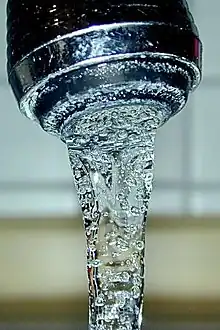
It is estimated that 8% of worldwide water use is for domestic purposes.[15] These include drinking water, bathing, cooking, toilet flushing, cleaning, laundry and gardening. Basic domestic water requirements have been estimated by Peter Gleick at around 50 liters per person per day, excluding water for gardens.
Drinking water is water that is of sufficiently high quality so that it can be consumed or used without risk of immediate or long term harm. Such water is commonly called potable water. In most developed countries, the water supplied to domestic, commerce and industry is all of drinking water standard even though only a very small proportion is actually consumed or used in food preparation.
844 million people still lacked even a basic drinking water service in 2017.[25]: 3 Of those, 159 million people worldwide drink water directly from surface water sources, such as lakes and streams.[25]: 3
One in eight people in the world do not have access to safe water.[26][27] Inappropriate use of water may contribute to this problem. The following tables provide some indicators of water use.
| Activity | Minimum, litres / day | Range / day |
|---|---|---|
| Drinking Water | 5 | 2–5 |
| Sanitation Services | 20 | 20–75 |
| Bathing | 15 | 5–70 |
| Cooking and Kitchen | 10 | 10–50 |
Environment
Explicit environment water use is also a very small but growing percentage of total water use. Environmental water may include water stored in impoundments and released for environmental purposes (held environmental water), but more often is water retained in waterways through regulatory limits of abstraction.[29] Environmental water usage includes watering of natural or artificial wetlands, artificial lakes intended to create wildlife habitat, fish ladders, and water releases from reservoirs timed to help fish spawn, or to restore more natural flow regimes.[30]
Environmental usage is non-consumptive but may reduce the availability of water for other users at specific times and places. For example, water release from a reservoir to help fish spawn may not be available to farms upstream, and water retained in a river to maintain waterway health would not be available to water abstractors downstream.
Recreation
Recreational water use is mostly tied to lakes, dams, rivers or oceans. If a water reservoir is kept fuller than it would otherwise be for recreation, then the water retained could be categorized as recreational usage. Examples are anglers, water skiers, nature enthusiasts and swimmers.
Recreational usage is usually non-consumptive. However, recreational usage may reduce the availability of water for other users at specific times and places. For example, water retained in a reservoir to allow boating in the late summer is not available to farmers during the spring planting season. Water released for whitewater rafting may not be available for hydroelectric generation during the time of peak electrical demand.
Challenges and threats
Threats for the availability of water resources include: Water scarcity, water pollution, water conflict and climate change.
Water scarcity
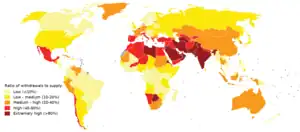
Water crisis is the lack of fresh water resources to meet the standard water demand. Two types of water scarcity have been defined: physical or economic water scarcity. Physical water scarcity is where there is not enough water to meet all demands, including that needed for ecosystems to function effectively. Arid areas (for example Central and West Asia, and North Africa) often suffer from physical water scarcity.[31] On the other hand, economic water scarcity is caused by a lack of investment in infrastructure or technology to draw water from rivers, aquifers, or other water sources, or insufficient human capacity to satisfy the demand for water. Much of Sub-Saharan Africa is characterized by economic water scarcity.[32]: 11
The essence of global water scarcity is the geographic and temporal mismatch between fresh water demand and availability.[33][34] At the global level and on an annual basis, enough freshwater is available to meet such demand, but spatial and temporal variations of water demand and availability are large, leading to physical water scarcity in several parts of the world during specific times of the year.[35] The main driving forces for the rising global demand for water are the increasing world population, improving living standards, changing consumption patterns (for example a dietary shift toward more animal products),[36] and expansion of irrigated agriculture.[37][38] Climate change (including droughts or floods), deforestation, increased water pollution and wasteful use of water can also cause insufficient water supply.[39] Scarcity varies over time as a result of natural hydrological variability, but varies even more so as a function of prevailing economic policy, planning and management approaches. Scarcity can be expected to intensify with most forms of economic development, but, if correctly identified, many of its causes can be predicted, avoided or mitigated.[40]Water pollution
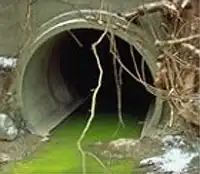
Many types of water pollution threaten water resources, but the most widespread, especially in developing countries, is the discharge of raw sewage into natural waters; this method of sewage disposal is the most common method in underdeveloped countries, but also is prevalent in quasi-developed countries such as China, India, Nepal and Iran.[41][42] Sewage, sludge, garbage, and even toxic pollutants are all dumped into the water. Even if sewage is treated, problems still arise. Treated sewage forms sludge, which may be placed in landfills, spread out on land, incinerated or dumped at sea.[43] In addition to sewage, nonpoint source pollution such as agricultural runoff is a significant source of pollution in some parts of the world,[44] along with urban stormwater runoff and chemical wastes dumped by industries and governments.[45]
Water and conflict
| Part of a series on |
| War |
|---|
Climate change
Climate change could have significant impacts on water resources around the world because of the close connections between the climate and hydrological cycle. Rising temperatures will increase evaporation and lead to increases in precipitation, though there will be regional variations in rainfall. Both droughts and floods may become more frequent in different regions at different times, and dramatic changes in snowfall and snow melt are expected in mountainous areas. Higher temperatures will also affect water quality in ways that are not well understood. Possible impacts include increased eutrophication. Climate change could also mean an increase in demand for farm irrigation, garden sprinklers, and perhaps even swimming pools. There is now ample evidence that increased hydrologic variability and change in climate has and will continue have a profound impact on the water sector through the hydrologic cycle, water availability, water demand, and water allocation at the global, regional, basin, and local levels.[52]
The United Nations' FAO states that by 2025, 1.9 billion people will live in countries or regions with absolute water scarcity, and two-thirds of the world population could be under stress conditions.[53] The World Bank adds that climate change could profoundly alter future patterns of both water availability and use, thereby increasing levels of water stress and insecurity, both at the global scale and in sectors that depend on water.[54]
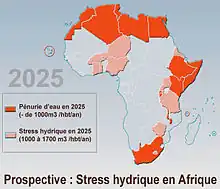
Management and governance
Water resource management and governance is handled differently by different countries. For example, in the United States, the United States Geological Survey (USGS) and its partners monitor water resources, conduct research and inform the public about groundwater quality.[56]
See also
- Deficit irrigation
- Flexible barge (bulk water transport)
- Peak water (water scarcity concept)
- Shared vision planning
- Socio-hydrology
- Virtual water
- Xerochore (European action plan)
References
- ↑ "Earth's water distribution". United States Geological Survey. Retrieved 2009-05-13.
- ↑ "Scientific Facts on Water: State of the Resource". GreenFacts Website. Retrieved 2008-01-31.
- ↑ Gleeson, Tom; Wada, Yoshihide; Bierkens, Marc F. P.; van Beek, Ludovicus P. H. (9 August 2012). "Water balance of global aquifers revealed by groundwater footprint". Nature. 488 (7410): 197–200. Bibcode:2012Natur.488..197G. doi:10.1038/nature11295. PMID 22874965. S2CID 4393813.
- ↑ "The World's Water 2006–2007 Tables, Pacific Institute". Worldwater.org. Retrieved 2009-03-12.
- ↑ Pulitzer Center on Crisis Reporting Archived July 23, 2009, at the Wayback Machine
- ↑ van Vliet, Michelle T H; Jones, Edward R; Flörke, Martina; Franssen, Wietse H P; Hanasaki, Naota; Wada, Yoshihide; Yearsley, John R (2021-02-01). "Global water scarcity including surface water quality and expansions of clean water technologies". Environmental Research Letters. 16 (2): 024020. Bibcode:2021ERL....16b4020V. doi:10.1088/1748-9326/abbfc3. ISSN 1748-9326.
- ↑ Andersson, K., Rosemarin, A., Lamizana, B., Kvarnström, E., McConville, J., Seidu, R., Dickin, S. and Trimmer, C. (2016). Sanitation, Wastewater Management and Sustainability: from Waste Disposal to Resource Recovery. Nairobi and Stockholm: United Nations Environment Programme and Stockholm Environment Institute. ISBN 978-92-807-3488-1
- ↑ Warsinger, David M.; Chakraborty, Sudip; Tow, Emily W.; Plumlee, Megan H.; Bellona, Christopher; Loutatidou, Savvina; Karimi, Leila; Mikelonis, Anne M.; Achilli, Andrea; Ghassemi, Abbas; Padhye, Lokesh P.; Snyder, Shane A.; Curcio, Stefano; Vecitis, Chad D.; Arafat, Hassan A.; Lienhard, John H. (2018). "A review of polymeric membranes and processes for potable water reuse". Progress in Polymer Science. 81: 209–237. doi:10.1016/j.progpolymsci.2018.01.004. ISSN 0079-6700. PMC 6011836. PMID 29937599.
- ↑ "Desalination" (definition), The American Heritage Science Dictionary, via dictionary.com. Retrieved August 19, 2007.
- ↑ Panagopoulos, Argyris; Haralambous, Katherine-Joanne; Loizidou, Maria (2019-11-25). "Desalination brine disposal methods and treatment technologies - A review". The Science of the Total Environment. 693: 133545. Bibcode:2019ScTEn.693m3545P. doi:10.1016/j.scitotenv.2019.07.351. ISSN 1879-1026. PMID 31374511. S2CID 199387639.
- ↑ Fischetti, Mark (September 2007). "Fresh from the Sea". Scientific American. 297 (3): 118–119. Bibcode:2007SciAm.297c.118F. doi:10.1038/scientificamerican0907-118. PMID 17784633.
- ↑ Ebrahimi, Atieh; Najafpour, Ghasem D; Yousefi Kebria, Daryoush (2019). "Performance of microbial desalination cell for salt removal and energy generation using different catholyte solutions". Desalination. 432: 1. doi:10.1016/j.desal.2018.01.002.
- ↑ "Making the Deserts Bloom: Harnessing nature to deliver us from drought, Distillations Podcast and transcript, Episode 239". Science History Institute. March 19, 2019. Retrieved 27 August 2019.
- ↑ Cohen, Yoram (2021). "Advances in Water Desalination Technologies". Materials and Energy. WORLD SCIENTIFIC. doi:10.1142/12009. ISBN 978-981-12-2697-7. ISSN 2335-6596.
- 1 2 3 "WBCSD Water Facts & Trends". Retrieved 2009-03-12.
- ↑ UN Water – Coping with Water Scarcity 2007. fao.org
- ↑ Molden, D. (Ed.) (2007) Water for food, Water for life: A Comprehensive Assessment of Water Management in Agriculture. Earthscan/IWMI.
- ↑ Chartres, C. and Varma, S. (2010) Out of water. From Abundance to Scarcity and How to Solve the World’s Water Problems FT Press (USA).
- ↑ Haie, Naim (2020). Transparent Water Management Theory: Sefficiency in Sequity (PDF). Springer.
- ↑ "Water Development and Management Unit – Topics – Irrigation". FAO. Retrieved 2009-03-12.
- ↑ "FAO Water Unit | Water News: water scarcity". Fao.org. Retrieved 2009-03-12.
- 1 2 Gordon L., D. M. (2003). "Land cover change and water vapour flows: learning from Australia". Philosophical Transactions of the Royal Society B: Biological Sciences. 358 (1440): 1973–1984. doi:10.1098/rstb.2003.1381. JSTOR 3558315. PMC 1693281. PMID 14728792.
- ↑ Filley, S. "How much does a cow need ?" (PDF). Archived from the original (PDF) on 12 May 2012. Retrieved 17 March 2012.
- ↑ Natural Resource Management and Environmental Dept. "Crops Need Water". Archived from the original on 16 January 2012. Retrieved 17 March 2012.
- 1 2 WHO, UNICEF (2017). Progress on drinking water, sanitation and hygiene : 2017 update and SDG baselines. Geneva. ISBN 978-9241512893. OCLC 1010983346.
- ↑ "Global WASH Fast Facts | Global Water, Sanitation and Hygiene | Healthy Water | CDC". www.cdc.gov. 2018-11-09. Retrieved 2019-04-09.
- ↑ Water Aid. "Water". Archived from the original on 16 April 2013. Retrieved 17 March 2012.
- ↑ Gleick, Peter. "Basic Water Requirements for Human Activities" (PDF). Archived (PDF) from the original on 29 June 2013. Retrieved 17 March 2012.
- ↑ National Water Commission (2010). Australian environmental water management report. NWC, Canberra
- ↑ "Aral Sea trickles back to life". Silk Road Intelligencer. Retrieved 2011-12-05.
- ↑ Rijsberman, Frank R. (2006). "Water scarcity: Fact or fiction?". Agricultural Water Management. 80 (1–3): 5–22. doi:10.1016/j.agwat.2005.07.001.
- ↑ IWMI (2007) Water for Food, Water for Life: A Comprehensive Assessment of Water Management in Agriculture. London: Earthscan, and Colombo: International Water Management Institute.
- ↑ S. L. Postel, G. C. Daily, P. R. Ehrlich, Human appropriation of renewable fresh water. Science 271, 785–788 (1996).https://www.science.org/doi/10.1126/science.271.5250.785
- ↑ H. H. G. Savenije, Water scarcity indicators; the deception of the numbers. Physics and Chemistry of the Earth B 25, 199–204 (2000).
- ↑ Mekonnen, Mesfin M.; Hoekstra, Arjen Y. (2016). "Four billion people facing severe water scarcity". Science Advances. 2 (2): e1500323. Bibcode:2016SciA....2E0323M. doi:10.1126/sciadv.1500323. ISSN 2375-2548. PMC 4758739. PMID 26933676.
- ↑ Liu, Junguo; Yang, Hong; Gosling, Simon N.; Kummu, Matti; Flörke, Martina; Pfister, Stephan; Hanasaki, Naota; Wada, Yoshihide; Zhang, Xinxin; Zheng, Chunmiao; Alcamo, Joseph (2017). "Water scarcity assessments in the past, present, and future: REVIEW ON WATER SCARCITY ASSESSMENT". Earth's Future. 5 (6): 545–559. doi:10.1002/2016EF000518. PMC 6204262. PMID 30377623.
- ↑ Vorosmarty, C. J. (2000-07-14). "Global Water Resources: Vulnerability from Climate Change and Population Growth". Science. 289 (5477): 284–288. Bibcode:2000Sci...289..284V. doi:10.1126/science.289.5477.284. PMID 10894773.
- ↑ Ercin, A. Ertug; Hoekstra, Arjen Y. (2014). "Water footprint scenarios for 2050: A global analysis". Environment International. 64: 71–82. doi:10.1016/j.envint.2013.11.019. PMID 24374780.
- ↑ "Water Scarcity. Threats". WWF. 2013. Archived from the original on 21 October 2013. Retrieved 20 October 2013.
- ↑ "Coping with water scarcity. An action framework for agriculture and food stress" (PDF). Food and Agriculture Organization of the United Nations. 2012. Archived (PDF) from the original on 4 March 2018. Retrieved 31 December 2017.
 Text was copied from this source, which is available under a Creative Commons Attribution 3.0 IGO (CC BY 3.0 IGO) license.
Text was copied from this source, which is available under a Creative Commons Attribution 3.0 IGO (CC BY 3.0 IGO) license. - ↑ Watts, Jonathan (2005-06-07). "100 Chinese cities face water crisis, says minister". The Guardian.
- ↑ Acharya, Keya (2012-08-01). "How India's cities came to drown in sewage and waste". Guardian Environment Network.
- ↑ Ocean dumping of sewage sludge is prohibited in the United States by the Marine Protection, Research, and Sanctuaries Act (MPRSA).
- ↑ "Basic Information about Nonpoint Source Pollution". Washington, DC: US Environmental Protection Agency (EPA). 2020-10-07.
- ↑ Wasting Our Waterways: Toxic Industrial Pollution and the Unfulfilled Promise of the Clean Water Act (Report). Denver, CO: Environment America. 2009.
- ↑ Tulloch, James (August 26, 2009). "Water Conflicts: Fight or Flight?". Allianz. Archived from the original on 2008-08-29. Retrieved 14 January 2010.
- ↑ Kameri-Mbote, Patricia (January 2007). "Water, Conflict, and Cooperation: Lessons from the nile river Basin" (PDF). Navigating Peace. Woodrow Wilson International Center for Scholars (4). Archived from the original (PDF) on 2010-07-06.
- ↑ United Nations Potential Conflict to Cooperation Potential, accessed November 21, 2008
- ↑ Peter Gleick, 1993. "Water and conflict." International Security Vol. 18, No. 1, pp. 79-112 (Summer 1993).
- ↑ Heidelberg Institute for International Conflict Research (Department of Political Science, University of Heidelberg); Conflict Barometer 2007:Crises – Wars – Coups d'État – Nagotiations – Mediations – Peace Settlements, 16th annual conflict analysis, 2007
- ↑ "Water Conflict Chronology". Pacific Institute. Retrieved April 14, 2014.
- ↑ "Water and Climate Change: Understanding the Risks and Making Climate-Smart Investment Decisions". World Bank. 2009. Archived from the original on 7 April 2012. Retrieved 2011-10-24.
- ↑ FAO Hot issues: Water scarcity Archived 25 October 2012 at the Wayback Machine. Fao.org. Retrieved on 27 August 2013.
- ↑ The World Bank, 2009 "Water and Climate Change: Understanding the Risks and Making Climate-Smart Investment Decisions". pp. 21–24. Archived from the original on 7 April 2012. Retrieved 24 October 2011.
- ↑ "GEO-2000 overview overview" (PDF). unep.org. Archived (PDF) from the original on 7 February 2017. Retrieved 22 September 2016.
- ↑ "Water Resources". www.usgs.gov. Retrieved 2021-09-17.